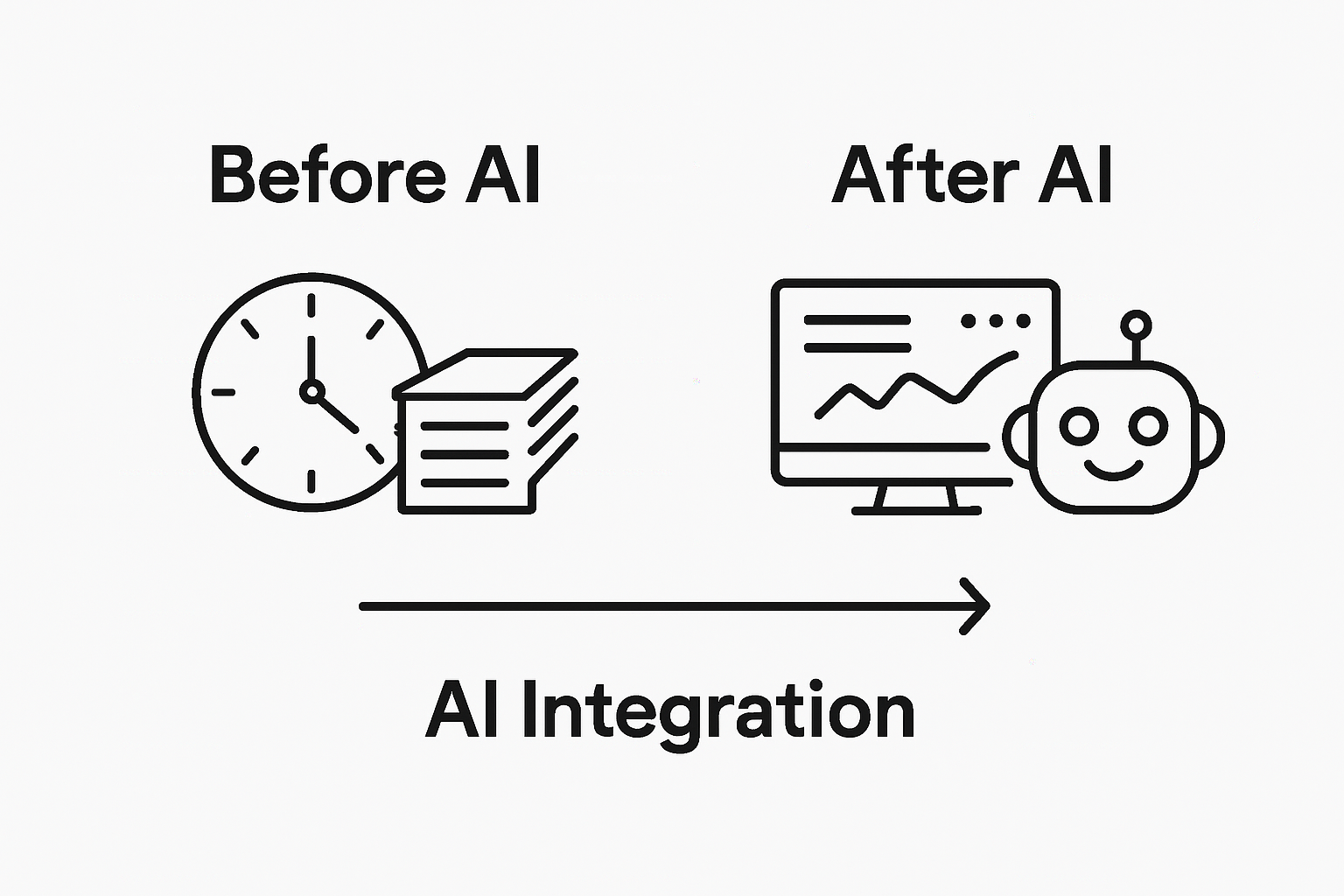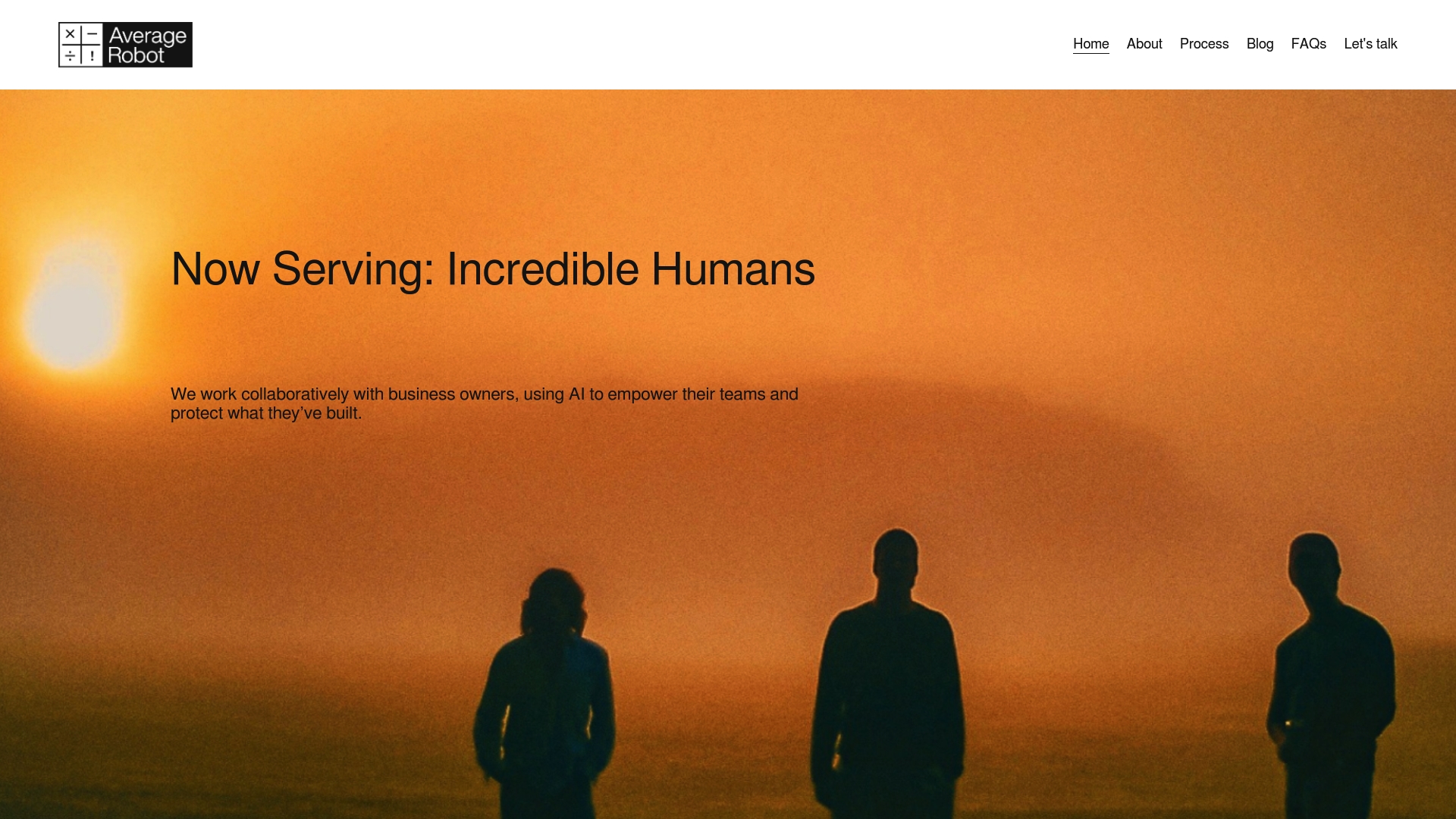Step by Step AI Adoption: Streamlining Business Operations

Getting started with AI in your business sounds overwhelming, right? The numbers say you are not alone. Over 60 percent of small business owners admit they have no clear plan to use AI tools at work. Most expect a tidal wave of change but feel lost with the first step. What if the secret is not about chasing the latest technology, but simply figuring out exactly where your biggest headaches hide?
Table of Contents
- Step 1: Assess Your Business Needs For AI Integration
- Step 2: Identify Suitable AI Tools And Technologies
- Step 3: Create An Implementation Plan With Timelines
- Step 4: Train Your Team On New AI Technologies
- Step 5: Monitor Performance And Gather Feedback
- Step 6: Optimize Processes Based On Insights
Quick Summary
| Key Point | Explanation |
|---|---|
| 1. Conduct a thorough internal audit | Evaluate all business processes to identify tasks that AI can improve or automate effectively. |
| 2. Create a cross-functional team | Involve various department representatives to gain diverse insights and identify AI opportunities. |
| 3. Develop a detailed implementation plan | Outline specific phases with timelines, objectives, and resources to guide AI adoption. |
| 4. Design a comprehensive training program | Train employees not only on technical skills but also on adapting to AI and collaboration. |
| 5. Monitor performance to gather insights | Continuously track AI performance metrics and collect feedback to refine processes and enhance integration. |
Step 1: Assess Your Business Needs for AI Integration
Successful AI adoption begins with a strategic assessment of your business’s unique operational landscape. Before diving into technological solutions, you need a comprehensive understanding of where AI can genuinely transform your current processes. This initial step is about mapping your business’s current performance, identifying friction points, and determining precise areas where artificial intelligence can deliver meaningful impact.
Start by conducting a thorough internal audit of your existing workflows. Walk through each department and critically examine repetitive tasks, bottlenecks, and areas consuming significant human resources. Look for processes that are time consuming, prone to human error, or require consistent pattern recognition. These are potential candidates for AI integration. For example, customer service teams might struggle with high volume inquiries, accounting departments might spend hours reconciling financial records, or sales teams might need better lead qualification mechanisms.
Your assessment should go beyond surface level observations. Quantify the current performance metrics for each potential AI implementation area. Calculate the time spent on specific tasks, error rates, operational costs, and employee satisfaction levels. These metrics will serve as your baseline for measuring AI’s eventual impact.

Read more about owner-led AI adoption strategies that can help you navigate this critical initial phase.
Consider creating a cross functional team representing different departments to provide diverse perspectives during this assessment. Their collective insights will help identify nuanced opportunities for AI integration that might not be immediately apparent from a single departmental viewpoint. This collaborative approach ensures that your AI strategy addresses genuine business needs rather than implementing technology for technology’s sake.
By the end of this assessment, you should have a clear document outlining:
- Specific business processes ripe for AI transformation
- Current performance metrics for those processes
- Estimated potential improvements through AI integration
- Initial challenges and potential mitigation strategies
Remember, the goal is not wholesale automation but strategic enhancement. AI should empower your team, not replace human expertise. Your assessment sets the foundation for a thoughtful, targeted approach to AI adoption that aligns closely with your business’s unique operational requirements.
Here is a summary table outlining each key step of the AI adoption process, including the main objective and the typical outcome you can expect from each stage.
| Step | Main Objective | Typical Outcome |
|---|---|---|
| Assess Needs | Identify operational areas for AI integration | Clear list of processes suited for AI transformation |
| Identify AI Tools | Select the most suitable AI technologies based on business needs | Prioritized shortlist of AI solutions with comparison metrics |
| Implementation Plan | Develop a phased rollout with defined milestones and resource allocation | Detailed project roadmap, resource plan, risk strategies |
| Train Team | Build team capability and confidence with AI tools | Team prepared with technical and practical AI skills |
| Monitor & Feedback | Track AI performance and collect insights from staff | Performance dashboards and feedback reports |
| Optimize | Refine AI-driven processes and maximize efficiency | Measurable process improvements and ongoing enhancement |
Step 2: Identify Suitable AI Tools and Technologies
After thoroughly assessing your business needs, the next critical phase involves exploring AI technologies that align precisely with your operational requirements. This step transforms your initial assessment into actionable technological solutions, requiring careful research, strategic evaluation, and alignment with your specific business objectives.
Begin by categorizing the AI tools based on the operational needs identified in your initial assessment. Different business functions demand specialized AI solutions. Customer service might benefit from natural language processing chatbots, while financial departments could leverage machine learning algorithms for predictive analytics and fraud detection. Research is key to understanding the nuanced capabilities of various AI technologies. Look for tools that offer not just automation, but intelligent adaptability to your unique business context.
Consider creating a comprehensive comparison matrix that evaluates potential AI technologies across multiple dimensions. Key evaluation criteria should include ease of integration with existing systems, scalability, cost effectiveness, vendor reputation, and specific feature sets. Pay close attention to the level of customization each tool offers. Learn more about strategic AI tool selection to ensure you make an informed decision.
Vendor selection requires thorough due diligence. Request product demonstrations, explore trial versions, and engage directly with solution providers to understand their implementation support. Look beyond marketing materials and seek real world case studies from businesses similar to yours. Ask pointed questions about data security, integration capabilities, and long term support.
This table provides a quick reference to compare evaluation criteria for AI tools and technologies discussed in the article, helping businesses structure their vendor selection process.
| Evaluation Criteria | Why It Matters | Example from Article |
|---|---|---|
| Ease of Integration | Ensures smooth adoption with existing systems | “Look for tools that offer not just automation, but intelligent adaptability to your unique business context.” |
| Scalability | Supports future business growth without frequent replacements | “Key evaluation criteria should include ease of integration with existing systems, scalability, cost effectiveness…” |
| Cost Effectiveness | Controls budget and ensures ROI | “Initial cost projections and ROI estimates” needed for decision making |
| Vendor Reputation | Reduces risk of failed support or implementation | “Request product demonstrations, explore trial versions, and engage directly with solution providers…” |
| Customization | Matches unique needs and allows adaption | “Pay close attention to the level of customization each tool offers.” |
| The right AI tool should feel like a collaborative partner, not just a software purchase. |
By the conclusion of this step, you should have:
- A prioritized list of potential AI technologies
- Detailed comparison matrix of selected tools
- Initial cost projections and ROI estimates
- Preliminary implementation roadmap
Remember that technology selection is not about finding the most advanced tool, but the most appropriate one for your specific business ecosystem. The goal is strategic enhancement that empowers your team and drives meaningful operational improvements.
Step 3: Create an Implementation Plan with Timelines
Transitioning from tool selection to actual implementation requires a meticulously crafted plan that balances technological integration with organizational readiness. Your implementation roadmap will serve as a strategic blueprint, guiding your team through the complex process of AI adoption while minimizing disruption to existing operations.
Strategic phasing is crucial when rolling out AI technologies. Rather than attempting a wholesale transformation, design an incremental approach that allows for continuous learning and adjustment. Begin with a pilot project in the most straightforward operational area identified during your initial assessment. This approach provides a low risk environment to test AI capabilities, validate assumptions, and build internal confidence. Explore our guide on strategic AI implementation to refine your approach.
Your implementation timeline should include clear milestones that define specific objectives, resource allocations, and expected outcomes. Break down the overall AI integration into digestible phases, typically spanning three to six months for each major operational area. Each phase should include detailed preparation steps, including staff training, system configuration, data migration, and performance monitoring. Anticipate potential challenges and build flexibility into your timeline, allowing room for unexpected technical complexities or organizational adaptation requirements.
Establish a dedicated cross functional team responsible for overseeing the AI implementation. This team should include representatives from IT, operations, human resources, and the specific departments directly impacted by the technological changes. Their collective expertise will be instrumental in identifying potential friction points, designing smooth transition strategies, and maintaining team morale throughout the implementation process.
By the conclusion of this planning stage, you should have developed:
- Comprehensive implementation timeline with specific milestones
- Resource allocation and budget projections
- Risk mitigation strategies
- Clear performance metrics for measuring AI integration success
Remember that successful AI adoption is not about perfect execution, but about creating a flexible, collaborative framework that allows your organization to learn, adapt, and continuously improve technological integration.
Step 4: Train Your Team on New AI Technologies
Training your team represents the critical human element in successful AI integration. This step transforms technological potential into practical operational capability, ensuring that your workforce understands not just how to use new tools, but how to collaborate effectively with artificial intelligence. Effective training goes beyond technical instruction it builds confidence and reduces resistance to technological change.
Design a comprehensive training program that addresses both technical skills and psychological adaptation. Begin with foundational workshops that demystify AI technologies, explaining how these tools complement human expertise rather than replace it. Create learning experiences that allow team members to understand the underlying principles of the AI technologies you are implementing. Interactive sessions where employees can experiment with the tools in controlled environments will help them develop hands on familiarity and reduce anxiety about technological transition. Discover strategies for empowering your team through AI adoption to maximize your implementation success.
Consider developing a tiered training approach that recognizes different learning speeds and technological comfort levels within your organization. Some team members might require more intensive instruction, while others might quickly adapt to new systems. Personalized learning paths that include a mix of group workshops, one on one coaching, online tutorials, and practical hands on exercises will ensure comprehensive skill development. Emphasize practical application by creating scenario based training that directly relates to your specific business processes.
Establish a continuous learning framework that extends beyond initial training. Technology evolves rapidly, and your team’s skills must keep pace. Implement regular refresh courses, create internal knowledge sharing platforms, and develop mentorship programs where more technologically adept team members can support colleagues. This approach not only enhances technical skills but also fosters a culture of collaborative learning and technological curiosity.
By the conclusion of your training initiative, you should have:
- Comprehensive training materials tailored to your specific AI technologies
- Measurable skill progression for team members
- Established internal support mechanisms
- Increased team confidence in AI tool utilization
Remember that successful AI adoption is fundamentally about empowering your human talent, not replacing it. Your training approach should reinforce that AI is a powerful collaborative tool designed to enhance, not eliminate, human capabilities.
Step 5: Monitor Performance and Gather Feedback
Performance monitoring represents the pivotal stage where theoretical AI implementation transitions into measurable operational improvement. This step is not about passive observation, but active, strategic assessment that transforms raw data into actionable insights. Continuous evaluation becomes your competitive advantage, allowing real time adjustments and optimization of your AI technologies.
Establish a robust performance tracking framework that captures both quantitative metrics and qualitative team experiences. Develop a comprehensive dashboard that monitors key performance indicators specific to each AI implementation area.
IMAGE:descriptive_key_1] These metrics might include processing time reduction, error rate minimization, cost savings, and productivity improvements. Implement automated reporting mechanisms that provide real time insights into how AI technologies are performing across different operational segments. [Explore advanced performance tracking strategies to refine your monitoring approach.
Create multiple feedback channels that encourage transparent communication from all team members. Beyond traditional performance metrics, understanding the human experience with new technologies is crucial. Develop anonymous survey mechanisms, regular check in meetings, and digital feedback platforms that allow employees to share both technical challenges and emotional responses to AI integration. This holistic approach ensures that your implementation strategy remains adaptable and responsive to both quantitative performance and team sentiment.
Adopt a proactive problem solving approach when performance data reveals inconsistencies or challenges. Schedule regular review sessions where cross functional teams can collaboratively analyze performance reports, discuss emerging patterns, and develop immediate corrective strategies. Treat performance monitoring as a continuous improvement cycle, not a one time assessment. This approach transforms potential obstacles into opportunities for technological and operational refinement.
By the conclusion of your monitoring phase, you should have:
- Comprehensive performance tracking dashboard
- Detailed feedback compilation from team members
- Identified optimization opportunities
- Clear performance improvement trajectory
Remember that successful AI adoption is an iterative process. Your monitoring strategy should remain flexible, allowing for continuous learning and adaptation as your technological ecosystem evolves.
Step 6: Optimize Processes Based on Insights
Optimization represents the transformative stage where collected performance data translates into strategic business improvements. This step is about intelligent refinement, using the insights gathered from your AI implementation to systematically enhance operational efficiency and technological integration. Meaningful optimization goes beyond surface level adjustments it requires a holistic understanding of how technological capabilities intersect with human potential.
Begin by conducting a comprehensive analysis of the performance metrics and feedback collected during your monitoring phase. Look for patterns that reveal not just technological limitations, but opportunities for process redesign. Identify areas where AI technologies are delivering substantial improvements and those requiring further calibration. Create a detailed optimization roadmap that prioritizes changes based on potential impact, implementation complexity, and alignment with broader business objectives. Discover advanced process optimization strategies to maximize your technological investments.
Collaborative optimization is key to sustainable transformation. Engage cross functional teams in the analysis and redesign process, ensuring that insights from different operational perspectives inform your strategic adjustments. Develop workshops where team members can collectively explore how AI insights can be leveraged to streamline workflows, reduce redundancies, and create more intelligent operational models. This approach not only improves processes but also builds organizational buy in and technological adaptability.
Implement a phased optimization approach that allows for incremental improvements and continuous learning. Start with low risk, high impact areas identified in your performance data. Develop pilot implementations of proposed process changes, carefully monitoring their effectiveness and gathering real time feedback. Create mechanisms for rapid iteration, allowing your optimization strategy to remain flexible and responsive to emerging insights.
By the conclusion of your optimization initiative, you should have:
- Comprehensive process improvement roadmap
- Implemented changes in key operational areas
- Measurable efficiency gains
- Enhanced team understanding of AI capabilities
Remember that optimization is not a destination but a continuous journey. Your goal is to create an adaptive organizational ecosystem where technological insights and human creativity continuously evolve together.
Unlock Your AI Advantage With Expert Guidance
Are you feeling the pressure to streamline your business operations but unsure where to start with AI? The article above breaks down each step of effective AI adoption, from assessing business needs to optimizing processes based on real data. If you are facing challenges like overcoming internal resistance, demystifying technology, or finding the right tools that fit your unique workflow, you are not alone. Mid-tier businesses often find that AI complexity and integration risks hold them back from unlocking true efficiency and team enthusiasm.

Now is the moment to bridge the gap between theory and action. At Average Robot, we specialize in transforming step-by-step AI adoption guides into tailored strategies for $20M+ ARR businesses. Our consultants partner closely with your leadership and teams, offering personalized AI-driven automations, roadmaps, and change management support that eliminate uncertainty. If you want a trusted council to fast-track your competitive edge without confusion, explore our solutions today. Let’s turn your operational pain points into a roadmap for growth. Visit Average Robot to start your transformation now.
Frequently Asked Questions
What are the first steps in adopting AI for my business?
Successful AI adoption begins with assessing your business needs. Identify areas where AI can genuinely transform current processes by conducting an internal audit of workflows and evaluating performance metrics.
How do I choose the right AI tools for my business?
After assessing your needs, categorize potential AI tools based on specific operational requirements. Consider factors such as ease of integration, scalability, vendor reputation, and the level of customization each tool offers.
What should be included in an implementation plan for AI technologies?
An implementation plan should outline a comprehensive timeline with specific milestones, resource allocation, risk mitigation strategies, and clear performance metrics to measure the success of AI integration.
How can I ensure my team is prepared for AI integration?
Train your team through comprehensive programs that include technical skills training and psychological adaptation. Use interactive sessions and provide continuous learning opportunities to build confidence and reduce resistance to change.




